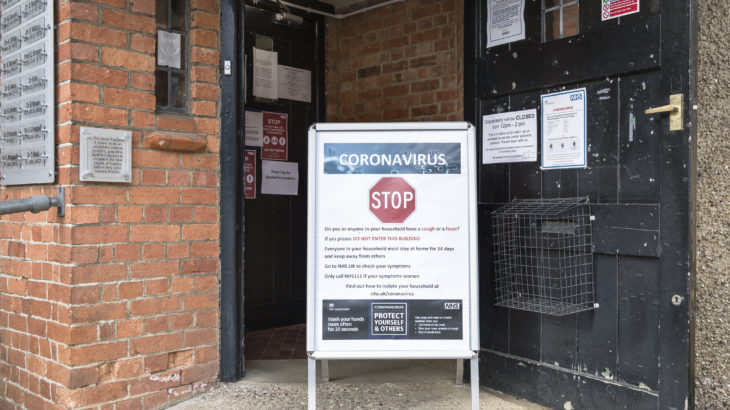VaxiMap: making life easier for GPs delivering vaccinations to housebound patients

Two engineering PhD students from the University of Oxford have created a simple online solution that enables GP surgeries across the UK to optimise the delivery of Covid-19 vaccinations to the UK’s one million housebound patients.
The Covid-19 crisis has created huge logistical problems for the whole of the NHS. One major issue has been the need for rapid roll-out of Covid-19 vaccination to the hundreds of thousands of people who cannot easily leave their homes – many of whom are particularly vulnerable to the effects of Covid-19 infection.
GP surgeries have never before needed to visit so many patients at home in such a short period of time, and this has placed enormous demands on surgeries, on top of workloads that were already busy before Covid-19 hit. The pressure is compounded by the urgent need to keep Covid-19 vaccine wastage to a minimum.
Areas with high levels of health inequalities – hence higher numbers of people requiring priority vaccination – face particular challenges, as do more rural and remote areas of the UK, where populations may be scattered or separated by geographical features such as mountains.
Project background
VaxiMap, a free website tool created by University of Oxford PhD students Rob Staruch and Tom Kirk, is a direct response to this problem. It provides mapping software, specially designed to work with GP practice data, that can quickly and easily generate efficient route maps for walking or driving.

The idea came about through contact between Rob Staruch and GP Dr David Andrews from Merthyr Tydfil, who had been a fellow student at medical school. Rob noticed that Dr Andrews was tweeting about the difficulty of planning routes to his housebound patients. Staff at the practice were inputting addresses individually into Google maps and using a manual process to work out which patients lived near each other, plotting journeys from postcode to postcode.
Rob, now clinical lead for the project, approached Tom Kirk, Vaximap’s technical lead, who he knew had the skills to build a tool that could automate the process of planning home visits. Tom designed a solution, and in discussion with Dr Andrews and other GPs, a prototype was quickly launched.
The project was also aided by prompt funding. Rob, who is a trainee burns and plastic surgeon in the Defence Medical Services, reached out to colleagues at jHubMed, part of the Ministry of Defence, who gave £7,500 towards costs. Oxford University Innovation (OUI) and Magdalen College also contributed to the project, while Microsoft came on board as technical partner via its Bing mapping services.
Feedback from the GPs enabled the system to be refined and improved, to the point where it could be formally launched in December 2020 as the current VaxiMap website. The tool is extremely easy to use: GP practice managers simply use their existing NHS patient database to create an Excel file with anonymised patient identifiers and locations, and upload it to the VaxiMap website, which then plots the optimum journey in seconds. The platform does not track any patient data, so it is entirely compliant with data protection legislation.
Impact
VaxiMap was quickly taken up by GP practices all over the UK. But it has been particularly popular with practices in the south-west because of the rural setting, older demographics, and more remote communities posing a greater logistical challenge for GPs. “I think that explains why GPs throughout Devon, Cornwall and Somerset were so keen on our service,” explains Tom. “Most of the feedback sent in was from them.”
The flexibility in the route mapping capability means that it works well for both rural and urban areas. By mid-May 2021 more than 27,000 routes had been built for almost 300,000 patients, leading to considerable savings of time – and thus money.
Feedback from users had indicated that manually planning routes for a group of 50 patients was taking practice staff at least two hours; this is reduced to a few minutes using VaxiMap. Following less than optimal routes was also adding to travel time; VaxiMap has been able to double the number of visits per hour, as one doctor confirms: “I have been working on the assumption that our housebound visiting vaccination service might be able to manage 2.5 jabs per hour. Our nurse tells me that yesterday using the output from your algorithm she managed a rate of five an hour. That transforms the deliverability.”
The total time saving now runs into tens of thousands of staff hours across the UK, split roughly 45:55 between GP practice managers and the nurses delivering the vaccinations; the saving in money terms is likely to be in excess of £500,000.
The future
VaxiMap’s application is not limited to the current Covid-19 crisis. It can be used in any scenario where medical practitioners need to visit multiple patients at home in one route, either to deliver healthcare facilities or to pick patients up. In fact, Rob and Tom have evidence that VaxiMap has already been used for other services such as district nurse visits, and some surgeries are planning to put it into routine use for yearly flu vaccination visits, as well an continuing to use it for Covid-19 vaccination, which looks set to become part of the annual vaccination schedule for high-risk groups.
In the longer term VaxiMap has scope to broaden the application of mapping and geolocation within health services. Although this would require significant development work, such systems could be added to the current web application.
Project contacts
Tom Kirk
VaxiMap technical lead
Rob Staruch
VaxiMap clinical lead

